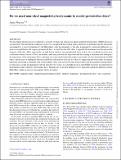Files in this item
Do we need non-ideal magnetohydrodynamic to model protostellar discs?
Item metadata
| dc.contributor.author | Wurster, James | |
| dc.date.accessioned | 2021-03-01T14:30:01Z | |
| dc.date.available | 2021-03-01T14:30:01Z | |
| dc.date.issued | 2021-03 | |
| dc.identifier | 272471742 | |
| dc.identifier | a8929934-f9f1-48d2-8d28-b29fe5a8d80f | |
| dc.identifier | 85100796453 | |
| dc.identifier | 000637320000081 | |
| dc.identifier.citation | Wurster , J 2021 , ' Do we need non-ideal magnetohydrodynamic to model protostellar discs? ' , Monthly Notices of the Royal Astronomical Society , vol. 501 , no. 4 , pp. 5873–5891 . https://doi.org/10.1093/mnras/staa3943 | en |
| dc.identifier.issn | 0035-8711 | |
| dc.identifier.other | Jisc: d407adab60d84d679aa520fde0cab1e3 | |
| dc.identifier.other | ORCID: /0000-0003-0688-5332/work/87404590 | |
| dc.identifier.uri | https://hdl.handle.net/10023/21531 | |
| dc.description | Jointly funded by STFC and the Large Facilities Capital Fund of BIS (STFC grants ST/K000373/1, ST/K0003259/1, and ST/M006948/1), and the University of Exeter Supercomputer, Isca, a DiRAC Facility jointly funded by STFC, the Large Facilities Capital Fund of BIS, and the University of Exeter. The equipment was funded by BEIS capital funding via STFC capital grants ST/K000373/1 and ST/R002363/1 and STFC DiRAC Operations grant ST/R001014/1. DiRAC is part of the National e-Infrastructure. | en |
| dc.description.abstract | We investigate and discuss protostellar discs in terms of where the various non-ideal magnetohydrodynamics (MHD) processes are important. We find that the traditional picture of a magnetised disc (where Ohmic resistivity is dominant near the mid-plane, surrounded by a region dominated by the Hall effect, with the remainder of the disc dominated by ambipolar diffusion) is a great oversimplification. In simple parameterised discs, we find that the Hall effect is typically the dominant term throughout the majority of the disc. More importantly, we find that in much of our parameterised discs, at least two non-ideal processes have coefficients within a factor of 10 of one another, indicating that both are important and that naming a dominant term underplays the importance of the other terms. Discs that were self-consistently formed in our previous studies are also dominated by the Hall effect, and the ratio of ambipolar diffusion and Hall coefficients is typically less than 10, suggesting that both terms are equally important and listing a dominant term is misleading. These conclusions become more robust once the magnetic field geometry is taken into account. In agreement with the literature we review, we conclude that non-ideal MHD processes are important for the formation and evolution of protostellar discs. Ignoring any of the non-ideal processes, especially ambipolar diffusion and the Hall effect, yields an incorrect description of disc evolution. | |
| dc.format.extent | 9346826 | |
| dc.language.iso | eng | |
| dc.relation.ispartof | Monthly Notices of the Royal Astronomical Society | en |
| dc.subject | Magnetic fields | en |
| dc.subject | (Magnetohydrodynamics) MHD | en |
| dc.subject | Methods: numerical | en |
| dc.subject | Protoplanetary discs | en |
| dc.subject | Dust | en |
| dc.subject | Extinction | en |
| dc.subject | QB Astronomy | en |
| dc.subject | QC Physics | en |
| dc.subject | DAS | en |
| dc.subject.lcc | QB | en |
| dc.subject.lcc | QC | en |
| dc.title | Do we need non-ideal magnetohydrodynamic to model protostellar discs? | en |
| dc.type | Journal article | en |
| dc.contributor.institution | University of St Andrews. School of Physics and Astronomy | en |
| dc.identifier.doi | https://doi.org/10.1093/mnras/staa3943 | |
| dc.description.status | Peer reviewed | en |
This item appears in the following Collection(s)
Items in the St Andrews Research Repository are protected by copyright, with all rights reserved, unless otherwise indicated.

